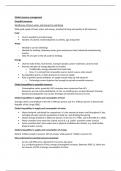Global resource management
Essential resources
Significance of food, water, and energy for well-being
With good supply of food, water and energy, standard of living and quality of life improves
Food
Food is needed to provide energy
Number of calories needed depends on activity, age and gender
Water
- Needed to survive (drinking)
- Needed for washing, disposing waste, grow and process food, industrial manufacturing
process
- Only 4% of water in the UK used for drinking
Energy
Used to make bricks, heat homes, transport people, power machinery, process food
Amount and type of energy depends on location
o Traditionally, energy released from fossil fuels
o Now, it is coming from renewable sources (wind, waves, solar power)
As population grows, so does pressure on resource supply
Rate of growth causes problems, as supply cannot keep up with demand
o Technology cannot improve fast enough to provide essential resources
Global inequalities in essential resources
- Consumption varies- generally, HICs consume more resources than LICs
- Resources are not evenly distributed- in LICs, as wealth grows, so does demand. Growing
demand and population size causes shortages of essential resources in LICs
Global inequalities in supply and consumption of food
Average calorie consumption in the UK is 3440 per person, but it is 1590 per person in Democratic
Republic of the Congo (DRC)
Global inequalities in supply and consumption of water
Water footprint calculated for comparison- it is the amount of water used throughout 1 day,
including all water used for production of food etc, and drinking/showering
Global average footprint is 3827L per person. In the US, it is 7786L, and in the DRC it is 1500L
Many countries have water but cannot access it, e.g. Sudan- economic water scarcity
Some countries don’t have water due to physical conditions like climate, e.g. Saudi Arabia-
physical water scarcity
Global inequalities in supply and consumption of energy
Richest 1 billion people consumer 50% of energy, while poorest 1 billion consume 4%
Why is demand for essential resources growing?
- As LICs and NEEs grow, demand for resources also grow
- E.g. as industry grows in China, energy consumption increases. Between 2003-11, there was
an increase of 53% of energy consumption in China
, Demand for food in the UK
How has demand for food changed in the UK?
Before supermarkets, fruit and vegetables were seasonal and locally sourced
More food was preserved for eating out of season
Now, exotic food is available all year round, and even seasonal fruit and vegetables are
imported, as they are grown more cheaply elsewhere
In 2017, 45% of the UK’s food supply was imported
How has the high demand for non-seasonal food created challenges and opportunities in LICs?
- Consumer demand in the UK affects imports
- Exotic and out-of-season food imported from places like Kenya and the Caribbean
- Land previously used for local food now used to provide high-value food for the UK
- High value can be because of the product, or because they are luxury items available out of
season
- Cost of products is high in the UK, but there are also challenges for people in LICs:
o Less land available for locals to grow food
o Often crops need huge amounts of water where there was a lack
o Sometimes people growing crops are exposed to chemicals (pesticides) without
protection
- Opportunities were also created:
o Jobs are created in farming, packaging, and transport
o Jobs supply wages
o From wages, taxes are paid to the government, which allows funding of facilities like
schools and hospitals
How and why has the demand for organic produce changed?
Organic produce: meat, fruit, and vegetables produced by organic farming (doesn’t use
pesticides or fertilisers)
Aim is to protect environment and wildlife by using natural predators to control pests
Farmers maintain fertility by rotating crops, using natural fertilisers
Animals farmed without antibiotics and drugs
Demand has been rising since the 1990s, as people are concerned about health
Reasons for choosing organic produce:
o Fewer chemicals and pesticides
o Natural and unprocessed
o Healthier
Organic produce is seen as luxury, so sales decreased during a recession in 2009-11
It is expensive because yields are lower
75% of all organic food is sold from supermarkets
Food miles and carbon footprints
Food miles: distance food travels from produce to consumer (not including from airport to
supermarket, or supermarket to home)
Carbon footprint: measure of impact that human activities have on environment in terms of
greenhouse gases emitted
How does importing food increase the UK’s carbon footprint
- UK’s total food miles was 19 million tonnes, which increase the UK’s carbon footprint
- The further a product travelled, the higher the food miles are





